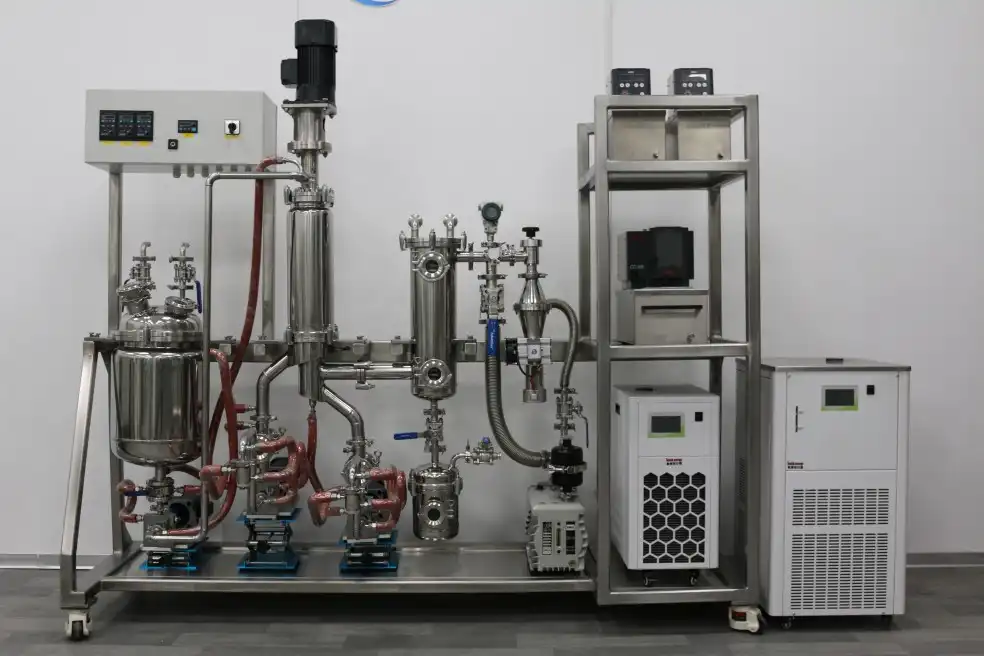Green and Efficient: Fish Oil Molecular Distillation Equipment in Sustainable Omega‑3 Production
Manufacturers worldwide face a critical challenge when producing pharmaceutical-grade omega-3 concentrates. Traditional purification methods destroy heat-sensitive EPA and DHA molecules, generate excessive waste, and fail to meet stringent regulatory standards. Fish Oil Molecular Distillation Equipment addresses these pain points by enabling gentle separation at vacuum pressures below 0.1Pa, preserving bioactive compounds while achieving purity levels exceeding 95%. This advanced technology transforms crude fish oil into premium nutraceutical ingredients without chemical solvents, reducing environmental impact while maximizing product value. As consumer demand for clean-label supplements intensifies and sustainability regulations tighten across pharmaceutical supply chains, understanding how molecular distillation optimizes omega-3 production becomes essential for maintaining competitive advantage in this rapidly evolving industry.

Understanding Fish Oil Molecular Distillation Technology
The Science Behind Short-Path Distillation
Fish Oil Molecular Distillation Equipment operates on fundamental principles of molecular mean free path. Unlike conventional distillation that relies on boiling point differences, this technology exploits the distance molecules travel before colliding. When operating under ultra-high vacuum conditions, lighter molecules like EPA and DHA ethyl esters travel farther than saturated fats and contaminants. The evaporation surface and condensation surface are positioned within one mean free path distance, typically 2-5cm apart. This proximity enables immediate condensation of desirable molecules while heavy impurities remain in the residue stream. The 316L stainless steel evaporator maintains precise temperature control through jacketed heating systems, preventing thermal degradation of polyunsaturated fatty acids. Centrifugal force from rotating wipers spreads feedstock into thin films measuring 0.3-1.0mm thickness, maximizing surface area for evaporation. Advanced ABB control systems monitor vacuum levels, heating zones, and feed rates in real-time, automatically adjusting parameters to maintain optimal separation efficiency throughout continuous production cycles.
Multi-Stage Separation for Maximum Purity
Industrial Fish Oil Molecular Distillation Equipment typically employs three to five sequential stages, each targeting specific compound classes. The first stage removes free fatty acids and low-molecular-weight oxidation products at 120-140°C under 1-5Pa vacuum. This deacidification step reduces acid value from 10mg KOH/g to below 0.3mg KOH/g while preparing feedstock for concentration. Second-stage distillation operates at 140-160°C and 0.1-0.5Pa, separating monounsaturated fatty acids and medium-chain triglycerides from omega-3 ethyl esters. The distillate from this stage contains 60-70% EPA plus DHA, suitable for standard dietary supplements. Third and fourth stages work at progressively lower temperatures and higher vacuum levels, fractionating EPA-rich and DHA-rich streams. Final polishing stages can push total omega-3 content beyond 90%, meeting pharmaceutical monograph specifications. Each stage recovers 92-98% of target molecules, with overall process yields reaching 70-85% depending on crude oil quality. Closed-loop solvent recovery systems capture and recycle any processing aids, achieving near-zero discharge operations. Temperature-controlled condensers prevent re-evaporation losses, while continuous feeding eliminates batch-to-batch variations in product composition.
Sustainability Advantages in Omega-3 Production
Energy Efficiency and Carbon Footprint Reduction
Modern Fish Oil Molecular Distillation Equipment delivers remarkable environmental benefits compared to traditional refining methods. Short-path distillation requires 30-40% less energy than conventional multi-column distillation systems because the low operating pressure reduces boiling points by 50-80°C. Heat recovery networks capture thermal energy from condenser cooling water and residue streams, pre-heating incoming feedstock to minimize fresh steam consumption. A typical 500L/hour system consumes 180-220kW compared to 350-400kW for equivalent fractional distillation capacity. High-efficiency vacuum pumps with variable frequency drives adjust pumping speed based on actual process requirements, eliminating constant full-load operation. Insulated process vessels and piping reduce radiant heat losses by 60%, while cascade refrigeration systems use ammonia or propane refrigerants instead of high-GWP synthetic alternatives. Life cycle assessments show carbon emissions of 0.8-1.2kg CO2e per kilogram of omega-3 concentrate, versus 2.5-3.5kg for chemical refining processes. Equipment designed for 20+ year operating lifespans with modular component replacement further improves sustainability metrics. Integration with renewable energy sources enables carbon-neutral production facilities, particularly in regions with abundant hydroelectric or wind power resources.
Waste Minimization and Circular Economy Integration
Fish Oil Molecular Distillation Equipment exemplifies circular economy principles through comprehensive waste valorization. Residue streams containing saturated fatty acids, cholesterol, and waxes become feedstock for industrial lubricants, soap manufacturing, and animal nutrition products rather than disposal liabilities. Light ends captured in first-stage distillation provide biodiesel blending components, closing the loop in biorefineries processing aquaculture waste. Solvent-free operation eliminates hazardous waste generation and associated disposal costs, simplifying environmental permitting and regulatory compliance. Closed-loop cooling systems with filtration and water treatment reduce freshwater consumption by 80% compared to once-through designs. Equipment constructed from fully recyclable stainless steel and borosilicate glass ensures end-of-life material recovery. Process automation minimizes batch rejections and off-spec production, reducing raw material waste to under 2% of throughput. Side-stream fractionation of minor lipid components yields high-value co-products like squalene, fat-soluble vitamins, and marine phospholipids that offset production costs. Zero-discharge designs with membrane filtration and evaporative crystallization eliminate liquid effluent treatment requirements. These waste reduction strategies generate 15-25% cost savings while meeting increasingly stringent environmental regulations in pharmaceutical manufacturing sectors.
Industrial Applications and Market Segments
Pharmaceutical-Grade API Production
Fish Oil Molecular Distillation Equipment serves as the cornerstone technology for producing United States Pharmacopeia and European Pharmacopoeia compliant omega-3 active pharmaceutical ingredients. Cardiovascular drug manufacturers require EPA concentrates exceeding 96% purity with triglyceride formation less than 5%, specifications achievable only through multi-stage molecular distillation. GMP-validated systems feature comprehensive documentation packages including equipment qualification protocols, process validation master plans, and batch record templates meeting FDA 21 CFR Part 11 requirements. Clean-in-place and sterilize-in-place capabilities with automated valve sequencing ensure aseptic processing for parenteral formulations. Trace contaminant removal capabilities extend beyond heavy metals and persistent organic pollutants to include emerging concerns like microplastics and PFAS compounds. Advanced analytical interfaces enable real-time process monitoring with near-infrared spectroscopy and mass spectrometry, providing continuous quality verification. Batch traceability systems with RFID integration track individual production lots from crude oil receipt through finished API packaging. Prescription omega-3 products like Lovaza and Vascepa rely on this technology to deliver consistent therapeutic efficacy. Market growth exceeding 8% annually drives continued innovation in pharmaceutical distillation systems, with particular emphasis on pediatric formulation support and injectable omega-3 emulsion production.
Nutraceutical and Functional Food Manufacturing
Dietary supplement producers leverage Fish Oil Molecular Distillation Equipment to create differentiated products commanding premium pricing in competitive retail markets. IFOS five-star certified supplements require oxidative stability specifications including peroxide values below 5 meq/kg and anisidine values under 20, parameters directly controlled through gentle molecular distillation processing. Triglyceride re-esterification following ethyl ester purification produces supplements with 2-3 times higher bioavailability than standard formulations, supporting marketing claims validated through clinical studies. Flexible distillation configurations enable custom EPA-to-DHA ratios tailored for specific health applications, from cognitive support formulas emphasizing DHA to cardiovascular products featuring EPA concentrations. Kosher and Halal certification-ready designs with dedicated processing trains prevent cross-contamination for specialty market segments. Organic certification compliance through solvent-free operation opens opportunities in natural products channels. Sports nutrition brands utilize concentrated omega-3 oils in protein powders, energy bars, and recovery beverages, applications requiring excellent oxidative stability during extended shelf life. Infant formula manufacturers source DHA concentrates for neural development support, with molecular distillation ensuring removal of environmental contaminants to pediatric safety thresholds. Pet nutrition represents emerging growth opportunity, with molecularly distilled fish oil commanding premiums in premium dog and cat food formulations.
Technical Specifications and Performance Parameters
Critical Operating Variables for Optimal Separation
Successful Fish Oil Molecular Distillation Equipment operation demands precise control over interdependent process variables. Evaporator temperature represents the primary separation driver, with optimal ranges varying based on compound volatility and thermal sensitivity. EPA ethyl ester separation typically occurs at 130-150°C while DHA requires 145-165°C, temperatures selected to prevent isomerization and oxidation reactions. Vacuum pressure directly impacts molecular mean free path, with pharmaceutical applications requiring 0.05-0.1Pa compared to 0.5-2Pa for nutraceutical production. Feed rate optimization balances throughput capacity against separation efficiency, with typical ranges of 2-8 kg per square meter of evaporator surface per hour. Rotor speed controls film thickness and residence time, affecting both evaporation rates and product degradation. Systems operating at 250-400 RPM generate sufficient centrifugal force for uniform film formation without excessive mechanical stress on temperature-sensitive molecules. Condenser temperature maintenance 40-60°C below evaporator temperature ensures complete vapor condensation while preventing re-evaporation losses. Material selection impacts both product purity and equipment longevity, with 316L stainless steel offering superior corrosion resistance for acidic omega-3 processing environments. Borosilicate glass components in laboratory and pilot systems provide visual observation capabilities during process development. Advanced monitoring instrumentation including differential pressure transmitters, resistance temperature detectors, and oxygen analyzers enable real-time process optimization through statistical process control algorithms.
Scalability from Laboratory to Industrial Production
Fish Oil Molecular Distillation Equipment demonstrates exceptional scalability through consistent geometric principles across capacity ranges. Laboratory units with 50-100mm evaporator diameters processing 0.5-2 L/hour establish baseline separation parameters during product development. Pilot-scale systems scaling to 200-300mm diameters and 20-50 L/hour throughput validate production economics and generate material for regulatory submissions and market testing. Industrial installations feature 400-1000mm evaporators handling 200-2000 L/hour, sufficient for facilities producing 500-5000 tons annually of omega-3 concentrates. Modular construction allows incremental capacity expansion through parallel train installation rather than complete equipment replacement. Computational fluid dynamics modeling predicts performance scaling behavior, reducing scale-up risk and accelerating commercialization timelines. Standardized process interfaces enable seamless integration with upstream esterification reactors and downstream re-esterification units. Distributed control systems with OPC-UA connectivity facilitate enterprise resource planning integration for production scheduling and inventory management. Contract manufacturing organizations utilize flexible multi-product distillation systems supporting 10-15 different omega-3 formulations with rapid changeover protocols. Continuous improvement programs leverage machine learning algorithms analyzing historical batch data to recommend parameter optimization strategies. Remote monitoring capabilities enable expert troubleshooting support, minimizing downtime and maintaining consistent product quality across geographic manufacturing networks.
Quality Assurance and Regulatory Compliance
Meeting International Certification Standards
Fish Oil Molecular Distillation Equipment manufacturers prioritize comprehensive certification portfolios addressing global regulatory requirements. CE marking demonstrates conformity with European Union machinery and pressure equipment directives, essential for sales into European Economic Area markets. UL certification validates electrical safety compliance with North American standards, covering power distribution, control systems, and instrumentation. ISO 9001 quality management system certification ensures consistent manufacturing processes and continuous improvement methodologies. Pharmaceutical equipment additionally requires ASME BPE certification for sanitary design and 3-A standards for cleanability validation. Explosion-proof electrical classifications prevent ignition risks when processing volatile organic compounds in classified hazardous locations. Material certificates providing full chemical composition and mechanical property traceability support equipment qualification activities. Welding procedure specifications and welder qualifications demonstrate structural integrity for pressure boundary components. Factory acceptance testing protocols verify equipment performance against user requirement specifications before shipment. Site acceptance testing following installation confirms proper operation under actual production conditions. Ongoing calibration programs maintain measurement accuracy for critical process instruments, with documentation supporting regulatory audits. Performance qualification studies demonstrate consistent product quality across operational ranges, establishing validated parameters for routine manufacturing. These certification investments differentiate professional equipment suppliers from low-cost alternatives lacking quality system rigor.
Process Validation and Documentation Requirements
Implementing Fish Oil Molecular Distillation Equipment in pharmaceutical facilities necessitates extensive validation documentation supporting regulatory submissions. Design qualification protocols establish that equipment specifications align with intended process requirements and good manufacturing practice expectations. Installation qualification verifies correct equipment assembly, utility connections, and safety system functionality before introducing product materials. Operational qualification challenges equipment performance across worst-case operating scenarios, documenting acceptable parameter ranges and alarm response. Process validation demonstrates consistent production of specification-compliant omega-3 concentrates through three consecutive commercial-scale batches. Cleaning validation proves effective residue removal between products, preventing cross-contamination in multi-product facilities. Analytical method validation ensures test procedures accurately measure critical quality attributes including purity, oxidation markers, and contaminant levels. Change control procedures govern equipment modifications, requiring impact assessments and re-qualification activities when altering validated parameters. Deviation investigation systems document out-of-specification events, root cause analyses, and corrective actions preventing recurrence. Periodic review processes assess continued process validity through trending analyses of quality metrics and process capability indices. Electronic batch records with secure audit trails meet regulatory expectations for data integrity under FDA 21 CFR Part 11 and EU Annex 11 requirements. These validation investments typically require 6-12 months and represent significant portions of total project costs, emphasizing the importance of selecting proven equipment platforms with established regulatory track records.
Conclusion
Fish Oil Molecular Distillation Equipment represents the definitive solution for sustainable, high-purity omega-3 production across pharmaceutical, nutraceutical, and functional food industries. This technology combines gentle thermal processing with ultra-high vacuum separation, achieving EPA and DHA concentrations exceeding 95% while preserving molecular integrity and minimizing environmental impact. Multi-stage distillation configurations deliver precise control over product composition, enabling customized formulations for diverse therapeutic and nutritional applications. Energy efficiency improvements of 30-40% compared to conventional methods, combined with solvent-free operation and comprehensive waste valorization, position molecular distillation as the environmentally responsible choice for forward-thinking manufacturers. Scalability from laboratory research through industrial production, supported by rigorous quality systems and regulatory compliance frameworks, ensures this technology meets the evolving demands of global omega-3 markets projected to exceed $5 billion annually by 2028.
Cooperate with Xi'an Well One Chemical Technology Co., Ltd
As a leading China Fish Oil Molecular Distillation Equipment manufacturer, Xi'an Well One Chemical Technology Co., Ltd brings nearly two decades of specialized expertise to synthesis and purification separation equipment. Since our 2006 founding backed by Xi'an NewSet Chemical Equipment Technology Co., Ltd., we have established ourselves as a premier China Fish Oil Molecular Distillation Equipment supplier serving pharmaceutical, food, petrochemical, essence, and fine chemicals industries worldwide. Our state-of-the-art facilities encompassing 1500㎡ offices, 500㎡ R&D laboratories, and 4500㎡ manufacturing space enable comprehensive services from feasibility studies through pilot testing and full-scale production implementation. Premium Quality defines our approach through carefully selected materials ensuring top-grade Fish Oil Molecular Distillation Equipment for sale. Our OEM and ODM capabilities deliver custom designs with 3D animation visualization, matched with UL Listed electrical accessories and Huber brand auxiliary equipment for compact, operator-friendly configurations. CE, ISO, UL, and SGS certifications demonstrate our commitment to international quality standards. We offer High Quality Fish Oil Molecular Distillation Equipment in single-stage, dual-stage, and three-stage configurations achieving vacuum degrees to 0.1Pa with ABB control systems and 316 stainless steel construction. One-year warranty coverage and lifetime maintenance support protect your investment. Our senior design team, CNC machining centers, and comprehensive assembly capabilities ensure precise manufacturing and surface finishes meeting stringent pharmaceutical requirements. Whether you need experimental thin film systems, pilot-scale molecular distillation, or industrial production equipment, our expert team delivers turnkey solutions optimizing your omega-3 production capacity and product quality. China Fish Oil Molecular Distillation Equipment wholesale pricing combined with technical excellence makes us your ideal partner. Contact our China Fish Oil Molecular Distillation Equipment factory today at info@welloneupe.com to discuss your project requirements. Discover competitive Fish Oil Molecular Distillation Equipment price options tailored to your application. Bookmark this resource for future reference when planning equipment upgrades or new facility installations. Let us transform your omega-3 production capabilities through proven molecular distillation technology.
References
1. Rubio-Rodríguez N, Beltrán S, Jaime I, de Diego SM, Sanz MT, Carballido JR. Production of omega-3 polyunsaturated fatty acid concentrates: A review. Innovative Food Science & Emerging Technologies. 2010;11(1):1-12.
2. Wanasundara UN, Shahidi F. Concentration of omega-3 polyunsaturated fatty acids of marine oils using molecular distillation. In: Nutraceutical and Specialty Lipids and Their Co-Products. CRC Press. 2006:172-187.
3. Breivik H, Haraldsson GG, Kristinsson B. Preparation of highly purified concentrates of eicosapentaenoic acid and docosahexaenoic acid. Journal of the American Oil Chemists' Society. 1997;74(11):1425-1429.
4. Ivanovs K, Blumberga D. Extraction of fish oil using green extraction methods: a short review. Energy Procedia. 2017;128:477-483.



